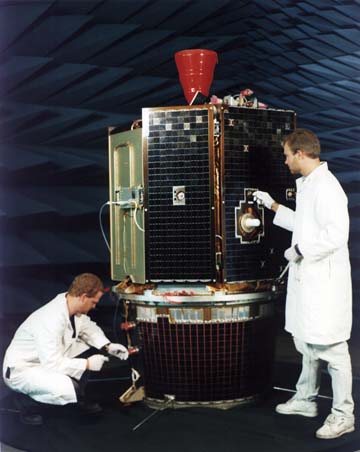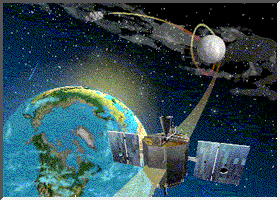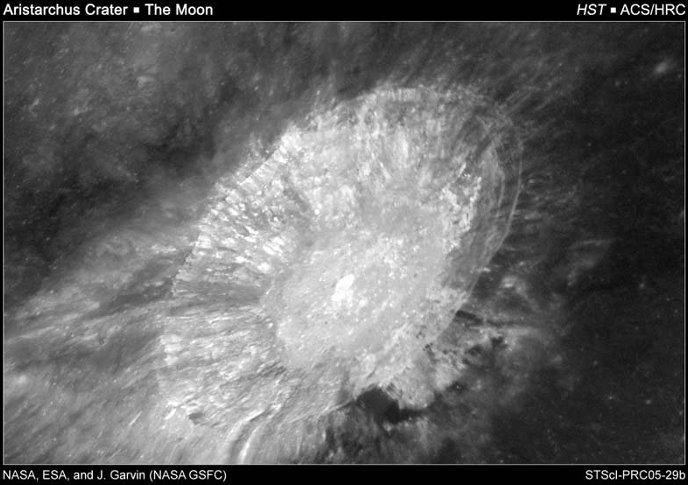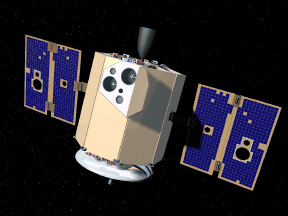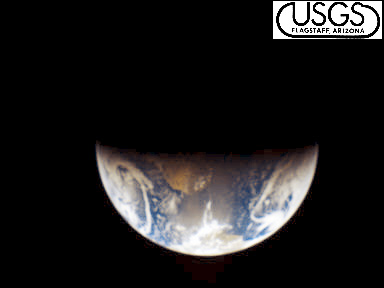|
.. |
||
|
The Mystery of Clementine Explored - Science Fiction or Truth? .
The Clementine satellite tested 23 advanced technologies during itsmission for the Ballistic Missile Defense Organization. In fulfilling its scientific goals, Clementine provided a wealth of information relevant to the mineralogy of the lunar surface. Using six on-board cameras designed and built at the Laboratory, Clementine mapped the entire surface of the Moon at resolutions never before attained. Clementine also provided range data that will be used to construct a relief map of the lunar surface. The first U.S. satellite to the Moon in more than two
decades was launched from Vandenberg Air Force Base (Santa Barbara County),
California, on January 25, 1994.
The satellite orbited the Moon for more than two months beginning February 19, 1994 taking and transmitting high-resolution pictures and range data until it built up a detailedmap of the entire lunar surface. Clementine completed its lunar orbit on May 3, 1994, sending back more than 1.5 million images of the Moon. Clementine's primary mission was to demonstrate in the harsh environment of space advanced, lightweight technologies developed by the Department of Defense for detecting and tracking ballistic missiles. Excerpt...
Excerpt...
Excerpt...
VISIBLE LIGHT {Normal Light} High-Resolution Camera This 1.1-kg camera operates at visible wavelengths (0.415 to 0.75 µm) with silicon CCD technology combined with a compact, lightweight image intensifier. To provide reliable, solid-state, cost-effective imaging
in the near ultraviolet,
visible, and near-infrared
regions of the spectrum (from 0.3 to 1.0 µm), LLNL designed and built
a medium-resolution, 0.426-kg camera that uses silicon charge-coupled device
(CCD) technology. For Clementine, this camera was
combined with a six position spectral filter wheel for remote sensing applications
and, specifically, for mineral typing studies of the Moon. The image below
shows the African continent imaged by the ultraviolet/visible camera at
five different wavelengths on a clear day from a distance of 384,000 km.
The above excerpts are taken from a PDF file on the
Clementine Mission
SOURCE Lawrence Livermore National Laboratory PDF File Comments:
What I don't understand here
is that the satellite left the moon May 5th on a path to the asteroid Geographos.
Two days later on May 7th, it malfunctioned and lost the fuel for atitude
control, and went into a spin. It had main thruster fuel. So how did a
satellite spinning at 81 rpm manage to manuever out of its path to the
asteroid and return to Earth, enter a stable geocentric orbit, and continue
to take images over Earth?
Also the mission to the asteroid was scrubbed because the images wouldn't be useful (due to the spin?), but after this miraculous feat of returning to earth without an attitude-control system, insertion into orbit, and now its taking okay pictures of the Earth? I am no rocket scientist, perhaps I am missing something - Zorgon This report also contains complete and irrefutable proof that they had the equipment to take visible light natural color images and did! See further below for images of the Earth taken by the same cameras in full natural color while in transit and looking back on arrival - Zorgon |
||
|
Excerpt: After mapping the Moon, Clementine departed for a flyby of the asteroid 1620 Geographos on 3 May 1994. After a few days, while rehearsing the datacollection sequence for the asteroid flyby, a software fault resulted in the firing (until fuel depletion) of the attitude-control thrusters. The spacecraft was spun up to over 80 rpm and could not be de-spun. Thus, the asteroid portion of the mission was cancelled. After flying near the Moon on 20 July 1994, Clementine went into solar orbit: it is hoped that renewed contact with the spacecraft can be established, in which case we will collect engineering data to Earth so that we can monitor the health and degradation of its sensors in a deep-space, hard-radiation environment. SOURCE Clementine Mission, The: Initial Results from Lunar Mapping Comments:
|
||
|
.
This is a composite photo using the Blue Earth image taken
with the medium resolution camera on board Clementine. The earth is actually
two times higher than the image shows and the black and white moon image
was added as a dramatic promotional image. The Earth in this image is also
enhanced and enlarged. {Compare to the original above}
A note below the image even states that;
|
||
|
.
Clementine was launched January 25, 1994, as a joint project between the Strategic Defense Initiative Organization and NASA. The objective of the mission was to test sensors and spacecraft components under extended exposure to the space environment and to make scientific observations of the Moon and a near-Earth asteroid (1620 Geographos). Due to a malfunction on May 7th, 1994, Clementine exhausted its fuel after the successful mapping of the lunar surface, and did not complete the visit to the asteroid. Comments:
|
||
| Naval Research Laboratory
The Pentagon announced on December 3, 1996, that radar data acquired by the Clementine spacecraft indicated ice in the bottom of a crater on the South Pole of the Moon. Although it is never lit by the Sun, there are a few images of the South Pole available for viewing. SOURCE: NRL Naval Research Laboratory Comments:
|
||
|
.
The above image was created by J.Garvin
and his team. It is a composite image that is one frame of an animation.
Below is the relevant data. You can compare the name on the image to those
below.
HST imagery of Aristarchus Crater draped over simulated topography Animators:
SOURCE: NASA/Goddard Space Flight Center Scientific Visualization Studio Comments:
|
||
|
Task Force Report: Annex D Clementine
SOURCE: USGS Flagstaff Arizona Comments:
|
||
|
.
Clementine was a joint project between the Ballistic
Missile Defense Organization (BMDO, nee the Strategic Defense Initiative
Organization, or SDIO) and NASA. The objective of the mission was to test
sensors and spacecraft components under extended exposure to the space
environment and to make scientific observations of the Moon and the near-Earth
asteroid 1620 Geographos. The Geographos observations were not made due
to a malfunction in the spacecraft. The lunar observations made included
imaging at various wavelengths in the visible as well as in ultraviolet
and infrared, laser ranging altimetry, gravimetry, and charged particle
measurements....
Excerpt
SOURCE: NASA National Space Science Data Center Comments:
This report ends Clementine June 1994. This one also says that Clementine was part of Strategic Defense Initiative Organization or "Star Wars" as it was called. - Zorgon |
||
|
In 1994, President Clinton cited Clementine as one of the major national achievements in aeronautics in space. He stated "The relatively inexpensive, rapidly built spacecraft constituted a major revolution in spacecraft management and design; it also contributed significantly to lunar studies by photographing 1.8 million images of the surface of the Moon." The President was not alone in his praise of Clementine. In addition to the President's comments, Clementine and the people associated with the program were presented with the following awards: * Popular Science magazine: Best of 1994's Top
100 Technologies
President Clinton Clementine II 27 October 1997 NEWS RELEASE: The National Space Society was disappointed to learn of President Clinton's recent line-item vetos of several small military space programs. The Clementine 2 asteroid intercept mission, as with Clementine 1, would have been the most cost-effective approach to combining important technology demonstrations with real scientific missions. Comments:
|
||
|
After 1976, the Moon was ignored by space probes until the U.S. Department of Defense's new Strategic Defense Initiative Organization (SDIO, aka "Star Wars") flew the Clementine 1 probe to map the Moon's surface with modern instruments, in conjunction with NASA. Clementine 1 arrived at the Moon in February 1994... Clementine 1 entered a polar orbit around the Moon in order to map its entire surface. Clementine 1 orbited the Moon for more than two months, totalling over 300 orbits, from February 19 to May 5, 1994. Clementine 1 left lunar orbit to rendezvous with near Earth asteroid 1620 Geographos, but a computer malfunction caused the spacecraft to fail before it reached the asteroid... Comment:
www.spds.nasa.gov/planetary/factsheet/neofact.html
|
||
|
CLEMENTINE can be found in the following categories: Space & Earth Science NORAD ID: 25978
NSSDC ID: 1999-064B
Discipline: Space Physics Sponsoring Agency/Country: Unknown/France Comments:
Okay sure why not? Nothing odd about that... _Zorgon |
||
| Albedo Map of the Moon U.S. Geological Survey
This provides the best albedo map produced to date for most of the far side. Although the images were acquired at a resolution of about 100 meters/pixel, they have been reduced to 1 km/pixel for this preliminary effort. Last Updated 10/19/2000 05:53:29 SOURCE: NRL National Resource Laboratory Comments:
Clementine Lunar Image Browser 1.5 Clementine captured 1.8 million images of the Moon's surface. The Laboratory provides the Clementine Lunar Image Browser as a courtesy to scientific researchers, as well as the general public, and you are welcome to browse the over 170,000 images that are available. SOURCE: NRL Navy Research Laboratory Comments:
Clementine Lunar Image Browser 1.5l New version of the Navy Browser Last updated 01/31/2006 10:52:01 SOURCE: NRL Navy Research Laboratory Comments:
|
||
|
Here are two more images from
the sUSGS proving once and for all that the camera on board Clementine
CAN AND DOES take real, normal, visible light spectrum images. The images
below were taken while Clementine was on its way to the moon.
SOURCE: CLEMENTINE - USGS IMAGES Comments: |
||
|
Department of Defense Released 07-24-2006 U.S. Department of Defense
Presenter: Dr. Dwight Duston, Assistant Deputy for Technology, Ballistic Missile Defense Organization; Tuesday, December 3, 1996 - 1:45 p.m. Subject: Discovery of Ice on the Moon Dr. Dwight Duston, Assistant Deputy for Technology,
Ballistic Missile Defense Organization;
Abstract One: Re: Water Ice on the Moon A: As I mentioned, what we can tell from looking at
the radar return is roughly the area that is covered by this. Assuming
it reflects ice like ice on Mercury -- making that assumption.That's been
well looked at. Then in order to see this back scatter effect, this roadside
reflector effect; it's estimated that we have to see some number of wavelengths
of our radar into the ice. In reviewing the paper, several of the reviewers
posited we probably need to see somewhere between 50 and 100 wavelengths.
So our wavelength is about six inches.
Q: That translates to what in volume? A: We were very conservative in the press release,
but if you take basically 100 square kilometers by roughly 50 feet, you
get a volume of something like a quarter of a cubic mile, I
Q: Can you compare that with something you know? A: It's a lake. A small lake. Abstract Two: Re: Clementine and Starwars A: However, there is still a space-borne component
to our theater and national missile defense architecture, and that is the
space-based infrared satellite. That will allow us to dotracking, particularly
in boost and in the mid-course phases of the trajectory of a ballistic
missile. So all the technologies that were demonstrated
on Clementine are technologies that we would hope would be either
used or would be the grand-daddies of technologies that we would eventually
use in our space surveillance platforms. So that part of the space
Q: But the role of the so-called Star Wars system now has shifted to more of a surveillance, as opposed to shooting something down... A: No, it is still based on shooting down ballistic missiles by impact with interceptors. So this technology is important in order to track and pass the track files on to the interceptors in order to allow them to hit their targets. So it's very much a part of the architecture. Abstract Three: Re: Where is Clementine Now Q: Where is Clementine now? A: The spacecraft, as you know, from the name Clementine, is only supposed to be here for a short period of time and be lost and gone forever, so it was intended for a very short period of time after this lunar mission, did a rendezvous with the earth, and shortly after that was shifted by the moon's gravity and continued a flight which will bring it back near the earth about nine years from now. So it's an 11 year total flight around the sun. So basically it's moving like a little planet around the sun, and it will bring it back close to us in about nine years... It's two years since it left us so it will be another nine years before it's back. (2005) But it's not useful right now. The mission is finished. Q: But unlike it's namesake, it's not lost and gone forever. It will be back? A: It will be back... Okay, so we have a lake on the Moon that is a hundred sqaure kilometers in area and 50 feet deep. Clementine WAS a Starwars program and its still out there... Not bad for a little lost spacecraft... |
||
|
|
||
|
at Above Top Secret Discussion Forum John Lear's Moon Pictures on ATS And Revealed for the First Time Color Images of the Moon from Clementine Satellite |
||
| FAIR USE NOTICE: This page contains copyrighted material the use of which has not been specifically authorized by the copyright owner. Pegasus Research Consortium distributes this material without profit to those who have expressed a prior interest in receiving the included information for research and educational purposes. We believe this constitutes a fair use of any such copyrighted material as provided for in 17 U.S.C § 107. If you wish to use copyrighted material from this site for purposes of your own that go beyond fair use, you must obtain permission from the copyright owner. | ||
| ~ MENU ~ |
